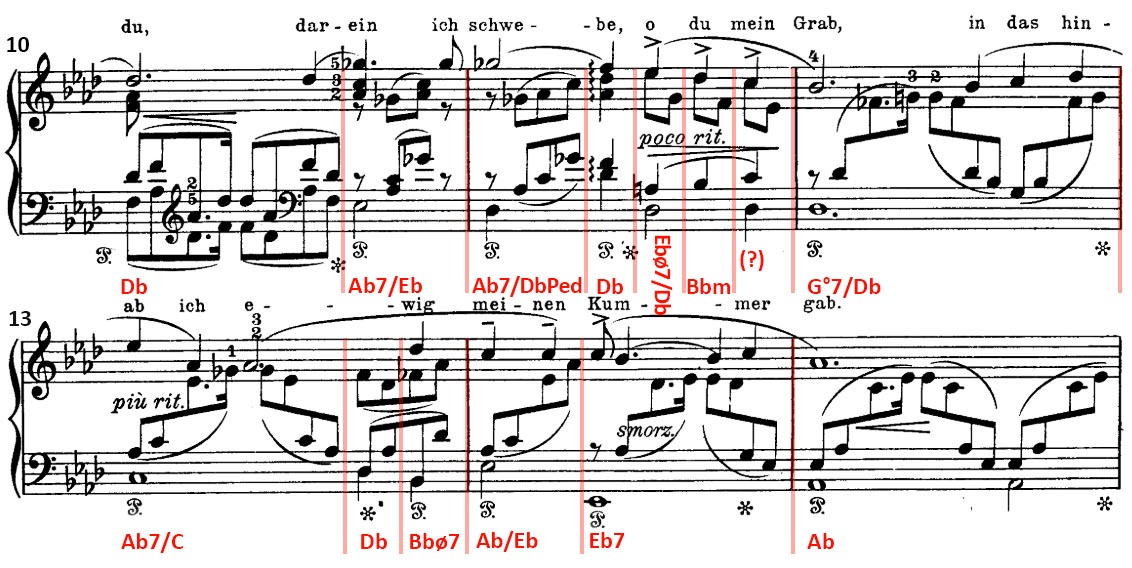Yes, diminished seventh chords usually resolve as leading tone chords and would be labeled as viio7 or viiø7 of the chord to which they resolve. Often the spelling is a clue to the function of the chord too: if you stack the chord in thirds, the bottom note should act as a leading tone. (This is not always the case; sometimes diminished sevenths are spelled differently to make them easier to read, etc.)
For your first example, your chord in bar 12 would be a viio7 of A♭. Stacked in thirds, that would be G-B♭-D♭-F♭. If you use inversion notation with Roman numerals, it would be viio4/3, which resolves to I6.
Half-diminished sevenths can also function as iiø7 chords, as on the last chord of bar 13 in your excerpt (which borrows the F♭ from the minor mode).
There are other less common functions of diminished sevenths, such as the so-called "common-tone" diminished seventh, where the fully-diminished seventh chord shares a common tone with its resolution chord. (Normally, when a diminished seventh functions as viio7, there will be no common tones with the resolution chord.) These usually function locally as ♯iio7 resolving up to I6 or ♯vio7 resolving up to V6.
The other chord in your excerpt in the middle of bar 11 is trickier. Yes, you might at first think it is enharmonically equivalent to a half-diminished seventh built on E♭, but that's not how it functions. If it were functioning as a viiø7 built on E♭, the E♭ would act as a leading tone and resolve up to F♭, which the chord doesn't do. And if it were acting as a iiø7, it would be functioning in the local key of D♭ and should usually resolve to V in D♭ (that is, A♭), again, which it doesn't do.
So what is this mystery chord? The key is the spelling. The way the notes are spelled is important, as they often tell how the individual notes are functioning. This chord is not spelled like a E♭ø7, which would have a B♭♭ instead of an A♮. The A♮ actually indicates it's part of the "active" interval of that chord -- the actual diminished seventh interval that resolves to the next chord is A♮-G♭, which resolves inward to B♭-F. One could therefore better think of this chord as an Ao7 without the C, that resolves to the next chord of B♭ minor, all over a D♭ pedal note. (Even better, I might not even think of these as individual "chords" at all, but rather just connecting notes -- passing tones -- between the previous harmony of the bar with descending lines in the right hand and an implied ascending A♭-A♮-B♭ in the left hand with its chromatic passing tone, all over a D♭ pedal.)
Lastly, to your "?" chord: that, I really wouldn't call a "chord" at all. Just like the chord I discussed in the previous paragraph, this is best thought of as connecting lines with a bunch of passing tones: D♭-C-B♭ and F-E♭-D♭ in the right hand, with C and E♭ as passing tones, while there's an ascending B♭-C-D♭ line in the left hand with passing note C, again over a D♭ pedal note.
It's important to remember that chordal analysis is a tool, but it's not necessarily representative of the way music is put together. Composers like Schumann would have spent a lot of time learning counterpoint and probably wouldn't have learned chordal analysis anything like what we do today. To him, all of these chromatic notes were not about building "diminished seventh chords" but rather about how individual lines in the accompaniment resolved and moved, introducing chromatic notes for color and sometimes to add tension that can then resolve. As you encounter increasingly chromatic music, keep in mind that many times a "chord" isn't really a "chord," but just a set of simultaneous notes, each of which has a different direction that they want to resolve to.

